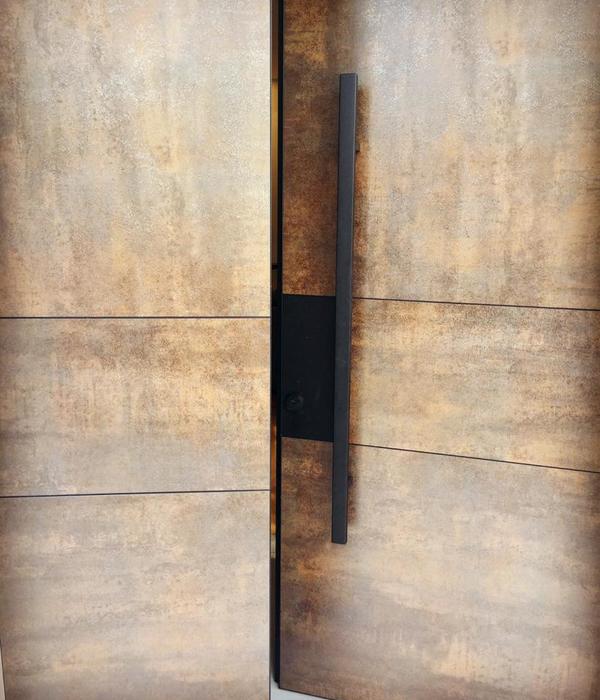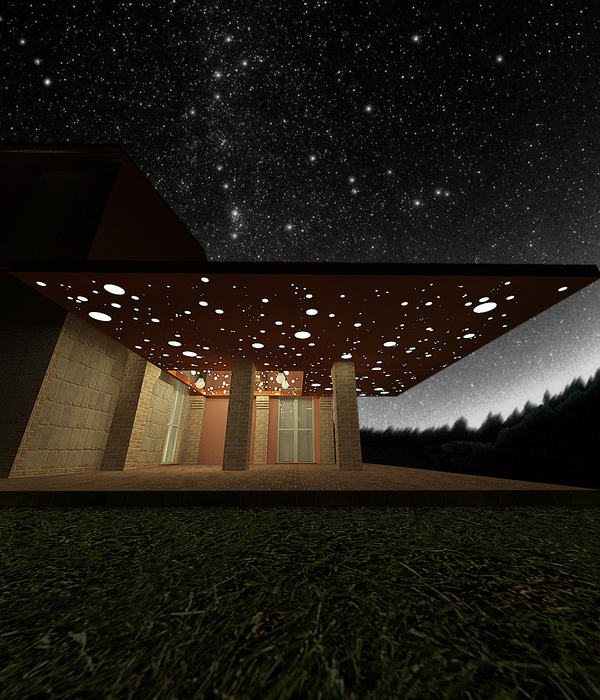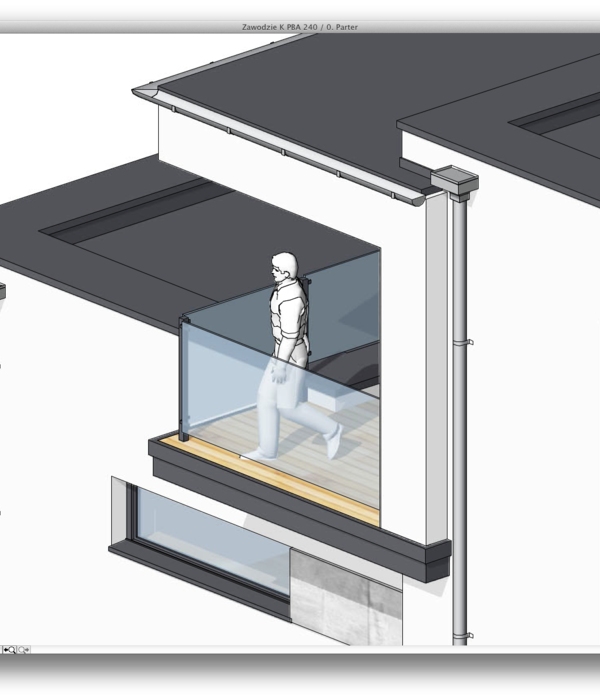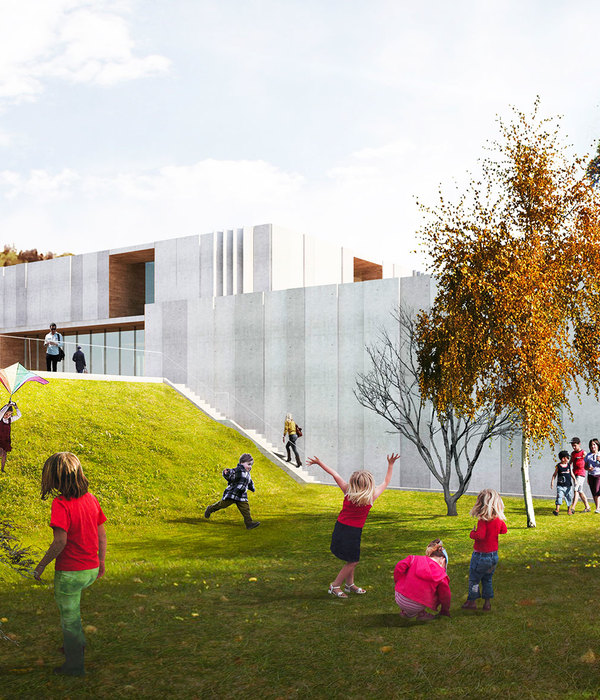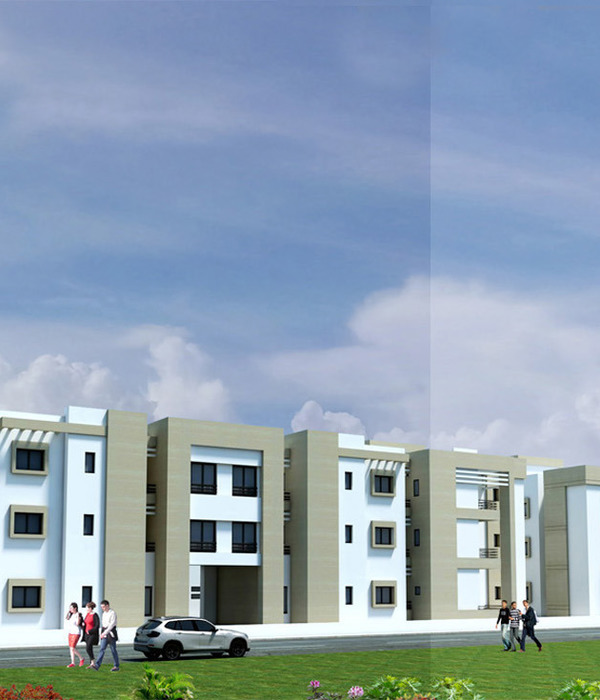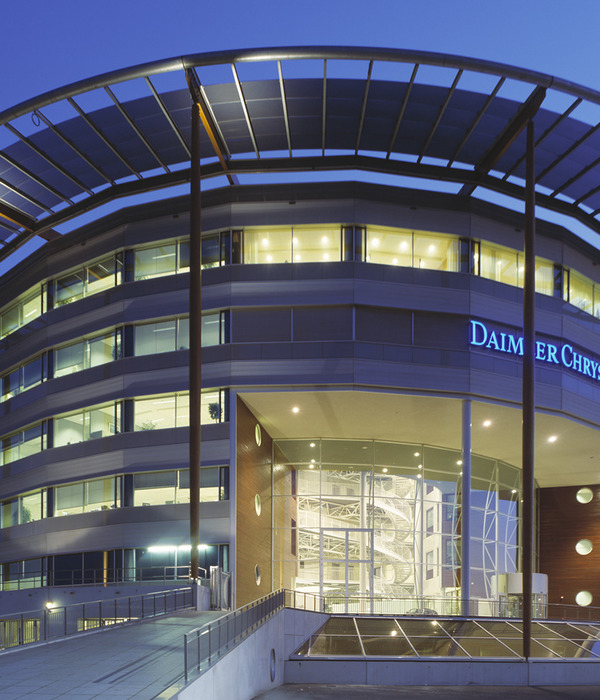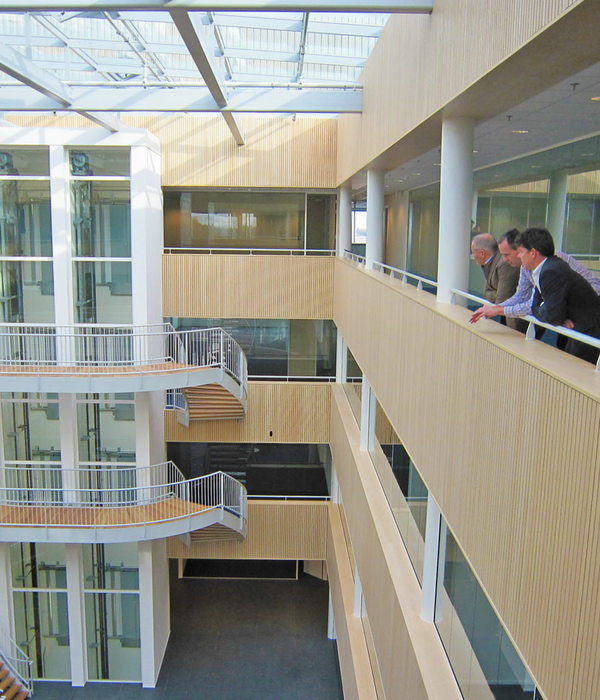Eclipse是为die开发商设计的一个全新垂直办公园区,位于杜塞尔多夫的肯尼迪大道,是审计和咨询公司普华永道(德国)的新址。这座高度可持续的园区由UNStudio和德国HPP建筑事务所协作设计,并由HPP建筑事务所负责实施。园区设计旨在为当今人才提供一个鼓舞人心和富有吸引力的工作环境,从而促进互动,激发创造力。
Designed for die developer, Eclipse is a new vertical work campus located on Kennedydamm in Dusseldorf and home to the auditing and consulting firm PwC Germany. The highly sustainable campus was designed in a collaboration between UNStudio and German architecture firm HPP Architects and was realised by HPP Architects. The main goal of the design for the campus is to foster interaction and to inspire creativity by providing an inspirational and attractive work environment for today’s talent.
▼室外公共空间,exterior communal space © H.G. Esch
▼主入口,entrance © H.G. Esch
这座60米高的建筑拥有约 27,000平方米采光充足的空间,1,200个办公场所分布其中。此外,大楼内部横跨16层,设有启发灵感的交流和体验区,而设计生动的中庭则构成了大楼的通信主干。这座垂直园区总体设计的愿景是打造立于周边街区之中的透明、开放的姿态。塔楼依照场地形状设计,平面布局呈三角形;它位于两层裙楼之上,地下两层为入口、物流、可停放455辆汽车的停车场和一个有200个车位的自行车库。
▼体量,volume
▼立面示意,facade diagram
▼terraces,露台
The 60 metre high building offers approx. 27,000 m2 of light-flooded, contemporary office space with approx. 1,200 workplaces. In addition, the interior, that spans 16 storeys, houses inspiring communication and experience areas, while lively atria form the communicative backbone of the building. The overall vision for this vertical campus is one of transparency and an open gesture towards the surrounding neighbourhood. The tower follows the shape of the site with a triangular floorplan and stands on a two-storey podium, while two basement levels provide the service entrance, delivery, parking for 455 vehicles and a 200 space bicycle storage.
▼外墙立面,facade © H.G. Esch
▼露台,terrace © H.G. Esch
360度立面 360-degree facade
Eclipse采用360度立面设计,与场地现状巧妙融合:北侧立面与肯尼迪大街平行,以便与通往杜塞尔多夫市中心的主干道保持一致,而南侧立面则与邻近的希尔顿酒店相呼应。裙楼以及无障碍屋顶花园与邻近建筑的低层部分直接衔接。Eclipse塔楼和希尔顿酒店同时勾勒了Eclipse屋顶花园和的主入口的形态。入口的对角线后移框架设计进一步强调了它的作用,而其外墙实体和透明部分的强烈对比则突出了这一框线设计。
With its 360-degree facade, Eclipse is thoughtfully integrated with the existing site: the northern facing facades are placed parallel to Kennedydamm in order to align with the main route to the centre of Düsseldorf, while the southern face is aligned with the neighbouring Hilton Hotel. The podium building, with its accessible rooftop garden, is directly connected with the lower section of this neighbouring building. Both the Eclipse tower and the Hilton Hotel frame the rooftop garden and the main entrance to Eclipse. This entrance is further accentuated with a diagonally framed setback that is accentuated by contrasting opaque and transparent portions of the facade.
▼入口空间,entrance area © H.G. Esch
为了突出主入口,并且区分裙楼和塔楼的体量,塔楼的末端悬挑于车道上方约11米处。形似漂浮的塔楼体量由一根立体的V型柱支撑。进入大楼时,可以顺畅地从室外过渡到室内大堂、会议设施和餐厅区。在这里,中央天窗提供了充足的日光,并使塔楼立面南侧的垂直景观一览无余。南侧立面主入口的设计再次呼应其理念,以便将大堂与裙楼另一侧的室外会议露台连接起来。
To emphasise the main entrance and to distinguish the volumes of the podium and the tower, the tip of the tower cantilevers approximately 11m above the driveway. The seemingly floating tower volume is supported by a three-dimensional V-shaped column. Entering the building is a smooth transition from outside to an inviting interior lobby, meeting facilities and a restaurant area. Here, a centrally located skylight provides generous daylight and allows for vertical views to the southern part of the tower facade. The principle of the main entrance is repeated on the southern facade, in order to connect the lobby with the outdoor conference terrace on the other side of the podium.
▼入口的V 型柱,V-shaped column at entrance © H.G. Esch
立体螺旋 3-dimensional helix
从空间组织和各项目之间的实际连接来看,垂直园区的主干是一个立体螺旋形状。一系列内部中庭空间沿着建筑外墙螺旋上升。它将各种办公功能连接起来,最后聚焦于全景屋顶花园,可用于举办社交活动。与典型外墙的规则网格不同,螺旋结构及其垂直集群的效果从室外望去清晰可见。大尺度和经典的立面部分对外彰显了中庭的体量。因此,高透明度的外立面使各功能的位置、规模和活跃程度从外向内一览无余,而中庭的立面则允许用户从内向外将城市美景尽收眼底。
▼立体螺旋示意图,communal helix diagram
The backbone of the vertical campus, in terms of its spatial organisation and physical connection of programmes, is a three-dimensional helix. A series of interior atrium spaces spiral upwards along the facade of the building. This connects various office programmes and culminates in a panoramic roof garden, which can be used for social events. In contrast to the regular grid of typical facades, the helix structure and its effect of clustering programmes vertically, is made visible from the outside. Large-scale and plain facade portions pronounce the volumes of the atria programmes to the outside. As such, a higher degree of transparency in the facades renders the position, scale and activity level of the programmes behind readable from outside, while from inside out, the atrium facades frame scenic views of the surrounding city.
▼中庭概览,atria overview © H.G. Esch
灵活的布局 Flexible organisation
在各楼层的平面布局中,中庭空间形成了特殊功能、连接和导向的重要目的地。除了提供个人工作空间外,中庭还设有协作、非正式工作空间,以及用于聚会、会议和咖啡休息的休息区。各个办公室都有良好的采光条件和高度的灵活性。它们可以转换成为景观办公室、独立空间或混合用途。在这里,可以实现专注、专用、不受干扰以及保密的工作程序。 作为一个辅助策略,中庭空间引入了连接、协作和交流的垂直校园理念。这个设计旨在将办公效率的合理性与社会盈余结合,为所有员工提供可社交、有意义和健康的办公环境。
▼公共空间示意图,communal spaces diagram
▼标准办公空间示意图,standard office diagram
In the organisation of the individual floor plans, the atrium spaces form important destinations for special programme, connection and orientation. In addition to the provision of individual workspaces throughout, the atria host collaborative, informal working spaces and breakout areas for encounters, meetings and coffee breaks. The individual offices have excellent daylight access and are highly flexible. They are designed to allow for adaptation into landscape-office, cell-office or a mix thereof. Here, focussed, specialised, undisrupted, and eventually confidential work routines are supported. As a complementary strategy, the atrium spaces introduce the idea of a vertical campus of connection, collaboration and communication. The intention here is to combine the rationality of office efficiency with a social surplus, making the work environment social, meaningful and healthy for all employees.
▼大楼内的公共空间,communal spaces in the buiding © H.G. Esch
▼办公区域,office area © H.G. Esch
▼小型会议室,small meeting room © H.G. Esch
可持续性 Sustainability
除了在设计中采取被动式可持续发展策略外,Eclipse还将配备 “智能发动机”技术。该技术由管理各个功能的传感器控制。日光、人工照明和室内通风都由个体来控制。这得益于2000个传感器,它们实时收集数据并传输给©智能引擎。因此,这种规模的建筑每年可减少多达200吨的二氧化碳排放量,这使Eclipse成为一座以可持续性为特征的办公建筑。大楼还设有200多个自行车停车位和电动汽车充电站,为未来的城市交通做出了贡献。内部空间交替使用,既可作为集中办公或单元式办公室,也可作为会议场所或休闲区。布局灵活可变,因此可以满足未来的多样化需求。
Eclipse计划获得DGNB白金或更高级别的钻石认证:这是对设计和建筑文化质量的最高认可。
In addition to the passive sustainable measures undertaken in the design, Eclipse will be eqipped with ‘smart engine’ technology. The technology is controlled by sensors that manage a variety of functions. Daylight, artificial light and room ventilation are all controlled by individual human presence. This is made possible by 2,000 sensors that collect data in real time and transmit it to the ©smartengine. As a result, up to 200 tonnes of CO2 savings per year can be achieved in a building of this size, which makes Eclipse a particularly sustainable office building. With over 200 parking spaces for bicycles and charging stations for e-cars, the building also contributes to the urban mobility of the future. The interior spaces alternate between concentrated work in cellular offices, while recreation zones function as meeting places. The layouts are flexible and reversible and as such can respond to future requirements.
For Eclipse, not only a DGNB Platinum certification is planned, but also DGNB Diamond: the highest recognition for design and building culture quality.
▼通高空间,double-height space © H.G. Esch
{{item.text_origin}}

